Reading Crypto Charts For Beginners
Cryptocurrency charts provide a visual representation of the price movements and other pertinent data of a particular asset, such as Bitcoin. These tools are vital for traders, investors, and enthusiasts to scrutinize historical price trends, spot patterns, and make informed decisions.
You can find crypto charts on popular sources like CoinMarketCap or trading platforms like WhiteBIT, where you will see all the needed information about digital assets and a crypto price list to analyze the situation in the market. To learn how to read crypto charts, read on.

How to Read a Crypto Chart?
Here’s an instructional guide on how to read Bitcoin charts, depending on the types of charts existing:
- Line chart. This rudimentary chart demonstrates Bitcoin’s closing prices over a specific time frame through a line connecting the data points.
- Candlestick chart. This more intricate chart provides additional information such as opening, closing, highest, and lowest prices within a particular period, and is composed of individual “candles.”
- Timeframes. Crypto charts can be displayed in various timeframes, such as minutes, hours, days, weeks, or months.
- Price axis. The right-hand vertical axis on the chart displays Bitcoin’s price levels. The numbers indicate Bitcoin’s value in a specific currency, such as dollars or euros.
- Time axis. The bottom horizontal axis on the chart represents the timeline. It depicts the period covered by the chart, with the most recent data on the right.
- Candlestick anatomy. Each candle on a candlestick chart represents a specific timeframe, comprising a rectangular body and two thin lines called “shadows.” The body symbolizes the price range between the opening and closing prices. If the body is colored or filled, it indicates a price drop (bearish). If it is empty or hollow, it denotes a price rise (bullish). The upper wick symbolizes the highest price reached during the timeframe, while the lower wick symbolizes the lowest price.
- Volume. Charts often exhibit a volume chart or graph underneath the price chart. Volume represents the number of Bitcoin units traded during a given timeframe. High volume usually accompanies significant price movements.
- Indicators. Crypto charts often contain indicators that aid traders in analyzing price patterns, trends, and market conditions.
- Trendlines are lines drawn on the chart to identify and visualize trends. An upward (ascending) trendline connects higher lows, indicating an uptrend. Conversely, a downward (descending) trendline connects lower highs, indicating a downtrend.
- Support and resistance levels where buying pressure is anticipated to prevent further price decreases. Resistance levels are price levels where selling pressure is anticipated to prevent further price increases. These levels can be recognized by observing areas where the price has historically reversed direction.
- Patterns. Crypto charts present various patterns, such as triangles, double tops, and head and shoulders, which can indicate potential price reversals or continuations.
Learning to recognize these patterns can be beneficial in making trading decisions.
Consistent practice and experience will enhance your ability to interpret and utilize crypto charts proficiently.
We Believe This Article Was Helpful, Don’t Hesitate To Share This Information With Your Friends On Facebook, Twitter, Whatsapp and Google plus.
Copyright Warning: Contents on this website may not be republished, reproduced, redistributed either in whole or in part without due permission or acknowledgement. All contents are protected by DMCA.
The content on this site is posted with good intentions. If you own this content & believe your copyright was violated or infringed, make sure you contact us via This Means to file a complaint & actions will be taken immediately.



